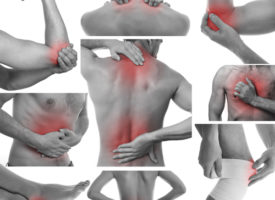In March of 1993, this article appeared in Health & Healing. It discusses reconstructive therapy—now more commonly known as prolotherapy—and it has provided thousands of patients long-term relief from all types of pain syndromes from back injuries and whiplash to knee and lower back pain. To schedule an appointment to receive prolotherapy at the Whitaker Wellness Institute, call (866) 944-8253. To find a doctor in your area who may be familiar with this procedure, visit www.aaomed.org.
This article may be 22 years old and the therapy may have a new moniker but prolotherapy worked then, it works now, and it will work for years and years to come. That’s the beauty of these timeless treatments. Enjoy!
A Cure for Low Back Pain and Other Miseries
March 1993
Following an auto collision six years ago, Rosemarie Kangery, RN, suffered from whiplash, which gradually worsened over the years. “I was constantly pushing my coat collar back because it felt like such a weight on my neck. I couldn’t turn my neck—I had painful muscle spasms,” she says. Periodic chiropractic adjustments or muscle relaxants provided only temporary relief.
A stiff neck wasn’t Kangery’s only problem. For years she had chronic lower back pain from a slipped lower lumbar vertebra. “If I lifted anything, I could be immobilized for a week.” Again, conventional measures—a back support, chiropractic treatment, physical therapy—were Band-Aids, not a cure.
Pain, Pain Everywhere
How would you rate Ms. Kangery’s chances of living a pain-free life? Judging by statistics, pretty dim. One in five Americans suffers from joint pain, the most common complaint being back pain, with untold millions afflicted with a stiff neck, knee pain, migraine headaches, carpal tunnel syndrome, sciatica, arthritis, tennis elbow, or a herniated disc.
Despite the high cost of treating all this misery—an estimated $80 billion—painkillers remain among Big-Pharma’s best-selling drugs, a sure sign that conventional treatments aren’t working. Orthopedic surgeons, who specialize in $30,000 back operations, admit (here I’m quoting from a medical article) that “failure…is…an accepted aspect of care for low-back disorders.”
A Happy Ending
Back to Ms. Kangery, a retired nurse. In December 1991, she learned about an osteopathic physician, Dr. William J. Faber, medical director of the Milwaukee Pain Clinic, who was using a method called “reconstructive therapy” (RT) to treat chronic joint pain. She began treatment soon after.
After four months of RT treatments, her neck improved; after one year, she had full range of motion. Today, “I can get in and out of the car without any difficulty, lift my own suitcase, and shovel my own driveway when it snows,” she reports.
One of the unexpected benefits of RT is her improved posture. “My friends tell me I look and act 10 years younger.”
What Is Reconstructive Therapy?
Reconstructive therapy (also known as sclerotherapy and prolotherapy) involves injecting an irritant solution into weakened areas of the body—mainly ligaments, tendons, cartilage, discs, and joints. When injured, these areas don’t heal well because of poor blood supply.
Use of the irritant solution causes a growth of new tissue, thus permanently strengthening the weakened areas and eliminating pain.
RT, which was discovered in the 1920s and perfected by subsequent practitioners, “is a natural method of stimulating a body’s own healing response,” explains Faber, who has specialized in RT since 1983 and is the coauthor of Pain, Pain Go Away [revised in 2009] and Instant Pain Relief.
An estimated 250 medical doctors and osteopaths in this country specialize in RT, and report that the treatment relieves pain in over 80 percent of patients with chronic pain.
Word Is Spreading
Close to a dozen scientific studies underscore the effectiveness of RT, but chances are you haven’t heard about it. One reason is that the treatment isn’t taught in medical schools—blame medicine’s narrow focus on drugs and surgery—and thus most doctors don’t even know that such a treatment exists.
Another problem is that drug companies can’t patent the RT solutions, so there’s no incentive for these companies to fund research or promote the treatment.
But word about the treatment is spreading. In the January 1993 issue of the Journal of Musculoskeletal Medicine, Dr. Vert Mooney, professor of orthopedics at the University of California, San Diego, writes, “A significant number of my own back pain patients who were resistant to other therapies have benefited from this [RT] treatment.”
What to Expect When You Have RT
If you have chronic joint pain, your eligibility for RT can only be determined by a physician trained in the technique. Injections of the irritant solution can cause tenderness, but 95 percent of patients don’t need anything more than Tylenol for pain relief. You will be advised not to take aspirin, Advil, or other nonsteroidal anti-inflammatory medicines, as they reduce your body’s natural inflammatory response.
After your treatment, you can expect some soreness and bruising at the injection site, and a temporary increase in stiffness. In most cases, though, ice or heat and gentle exercise relieve the discomfort.
The rate varies at which tissue regeneration takes place, but some patients notice progress after the very first session. However, most conditions require several treatments. You should notice an overall improvement, and feel progressively better with each treatment. Your doctor will work with you to prescribe a course that should result in complete recovery.


